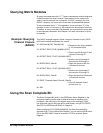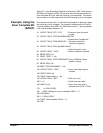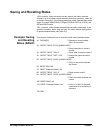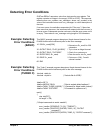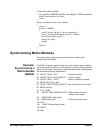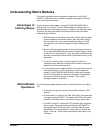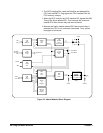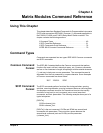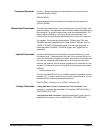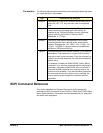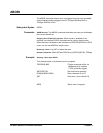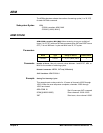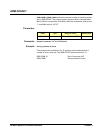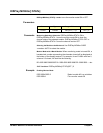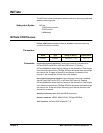
50 Matrix Modules Command Reference Chapter 4
Command Separator A colon (:) always separates one command from the next lower-level
command as shown below:
[ROUTe:]SCAN
Colons separate the root command from the second-level command
([ROUTe:]SCAN).
Abbreviated Commands The command syntax shows most commands as a mixture of upper- and
lowercase letters. The uppercase letters indicate the abbreviated spelling for
the command. For shorter program lines, send the abbreviated form. For
better program readability, you may send the entire command. The
instrument will accept either the abbreviated form or the entire command.
For example, if the command syntax shows TRIGger, then TRIG and
TRIGGER are both acceptable forms. Other forms of TRIGger, such as
TRIGG or TRIGGE will generate an error. You may use uppercase or
lowercase letters. Therefore, TRIGGER, trigger, and TrigGeR are all
acceptable.
Implied Commands Implied commands are those that appear in square brackets ([ ]) in the
command syntax. (The brackets are not part of the command and are not
sent to the instrument.) Suppose you send a second-level command but do
not send the preceding implied command. In this case, the instrument
assumes you intend to use the implied command and it responds as if you
had sent it. Examine the portion of the [ROUTe:] subsystem shown below:
[ROUTe:]
CLOSe<channel_list>
The root command [ROUTe:] is an implied command (indicated by square
brackets ([ ])). To make a query about a channel’s present status, you can
send either of the following command statements:
ROUT:CLOSe? <channel_list> or CLOSe? <channel_list>
Linking Commands Linking IEEE 488.2 Common Commands with SCPI Commands. Use a
semicolon (;) between the commands. For example, *RST;OUTP ON or
TRIG:SOUR HOLD;:*RST.
Linking Multiple SCPI Commands. Use both a semicolon (;) and a colon (:)
between the commands, such as ARM:COUN 1;:TRIG SOUR EXT.



